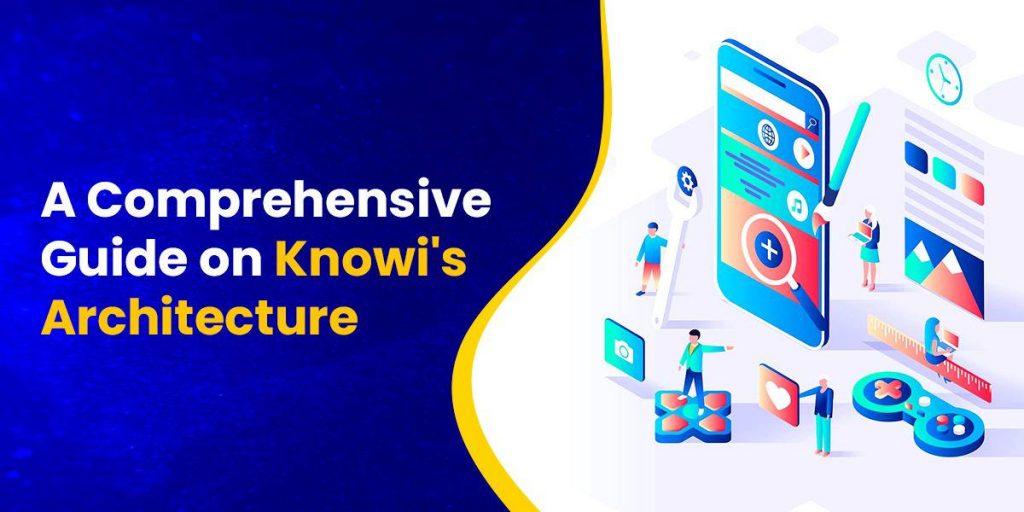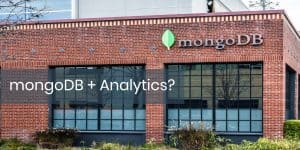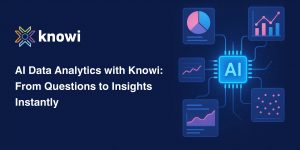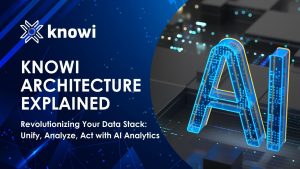What is the data extraction approach you follow today?
You first fetch the data, transport the raw data into a warehouse, use transformation tools to transform it, and then store it back. In this whole process,
- You’re paying for the transportation tool;
- You’re paying for storage;
- You’re paying for transforms;
This all makes it tricky and difficult to monitor the business data. However, with Knowi, there is no need to work with three different tools. This agile-formulated approach is best to fetch the data quickly and in real time.
In this blog, we will cover:
- Workflow of Knowi
- What Does Dataset Allow You to Do?
- Data Strategy Modes
- Pull/Push data API
- Elements of Knowi Architecture
- Conclusion
Workflow of Knowi
Knowi offers a Dataset-as-a-Service layer that provides a reliable and reusable set of data models across the enterprise.
Have a look at the architecture of the Knowi:
Let’s dive deep into this layer of Knowi.
It supports native queries into NoSQL, SQL databases, as well as other sources. This allows you to avoid standard ETL processing, such as sending data into a structured warehouse.
Queries can be run in real-time against your database, or they can be stored for faster processing/to protect your database from frequent analytical workloads.
The results of any query (real-time/direct as well as non-direct) are regarded as a dataset in Knowi. A dataset can span numerous data sources/queries and abstract the underlying complexity of execution modes, runtime parameters, and transformations. Additionally, datasets can be reused as inputs for subsequent searches.
With these data sets, users can thoroughly transform their business without having to move or ship the underlying raw data. It can connect to any of your existing data warehouses, files, or anything else via an API, and can also join across data sources.
Let’s imagine you have data in Elasticsearch and MySQL databases that you want to join. You can create those queries in no way across both and push those queries down in parallel. You can do transformations, clean it up, and then the final data is your dataset.
In simple language, Dataset is the result of a query.
What Does Dataset Allow You to Do?
With datasets ready, you can do the following tasks:
- Reuse Queries
- Abstract underlying Query execution details
- Define Security/Governance/Row-Level Security
- Create Multiple Visualizations/Transformations from the same dataset
- Natural Language Queries (Search-Based Analytics) using NLP
- Define Alerts and scheduled actions
You can also manage:
- Overall Summary
- Data Types
- Query History
- Usage
- Dataset Lineage (Query/Dataset/Visualizations flow)
- Query Execution Details
- Search-Based Analytics configuration
Data Strategy Modes
There are 3 different data strategy modes provided by Knowi:
Direct
Queries are directly executed on the original datasource. No need for storage. While the widget gets displayed, the data is fetched in real-time.
ElasticStore
Queries are executed and stored in Knowi ElasticStore. It is beneficial for long-running queries, reduces the load on databases, etc.
The query can be executed once or at scheduled intervals through overwrite strategies such as Append, TTL, key-based upsert, etc.
Write Back
Write back is similar to Elasticstore with the exception that a dataset can be written into your own data warehouse.
Pull/Push data API
Knowi’s 2 modes of working with data are as described below:
Pull Data
This is to extract the data from existing databases using UI and/or Cloud9Agent.
Push Data
This is to send real-time data through API. It uses HTTP POST requests.
Elements of Knowi Architecture
Dashboards/Visualizations
The dashboard is the main interface of Knowi where users land after login. In this UI, you can create/delete a dashboard, add/delete widgets, shrink or expand the size of the widget, change the name of the dashboard, and can also share it with multiple internal users within your organization.
Search-Based Analytics
With Knowi’s search-based analytics, users can ask any query to Knowi in plain English through NLP. It integrates with Slack/Teams and provides actionable data and visualizations on the spot. For example, you can throw a direct question like “What is the average satisfaction rating” and as a result, Knowi will immediately return the actionable data and visualization as can be observed in the illustration below:
Knowi also makes it possible to embed its search-based analytics in your application through SSO (Single Sign-on).
Alerts
Knowi’s alerts help you to keep on top of critical changes in your business in one place and drive actions. It let you improve data management by monitoring query execution and receiving real-time notifications when particular thresholds and criteria are satisfied, or when anomalies are found in your data.
Machine Learning Models
Knowi Adaptive Intelligence simplifies the process of utilizing machine learning to analyze data. Given a training dataset, Knowi can use classification or regression techniques to extract useful insights from it.
Simply select the Machine Learning icon, establish your workspace, and let Knowi walk you through the processes required to develop your Machine Learning models to get started!
Actions
It can range from sending reports from the dashboard to Slack or email as well as sending data via webhooks to third-party systems.
Conclusion
Knowi is an end-to-end BI tool that has the capability to completely transform the way the data is extracted and used in businesses. The “Dataset-as-a-Service” layer incorporates a strong foundation for this tool that can give you a glimpse of its powerful capabilities.






